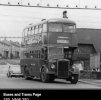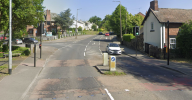This cropped up on a Bus facebook group
Its a Leeds City Transport bus going over a level crossing. Its from an era when there were no electrified lines in Leeds but its probably a private hire widening the area where it could be
But of interest to the rail section of this site are the rows of bells either side of the crossing, presumably to protect the wires from high vehicles
Was that a general thing in early electrification? And is it an installation still done today?
I think I have only seen 1 row of bells and that was on the West Coast line somewhere near Beattock. And that was some time ago.
Anyone know the location


Its a Leeds City Transport bus going over a level crossing. Its from an era when there were no electrified lines in Leeds but its probably a private hire widening the area where it could be
But of interest to the rail section of this site are the rows of bells either side of the crossing, presumably to protect the wires from high vehicles
Was that a general thing in early electrification? And is it an installation still done today?
I think I have only seen 1 row of bells and that was on the West Coast line somewhere near Beattock. And that was some time ago.
Anyone know the location


Last edited by a moderator:

![NNW-380_lr_thumb[1].jpg NNW-380_lr_thumb[1].jpg](https://www.railforums.co.uk/data/attachments/141/141253-3d7c62d939a8929fd1c327ac97f1abf6.jpg)
